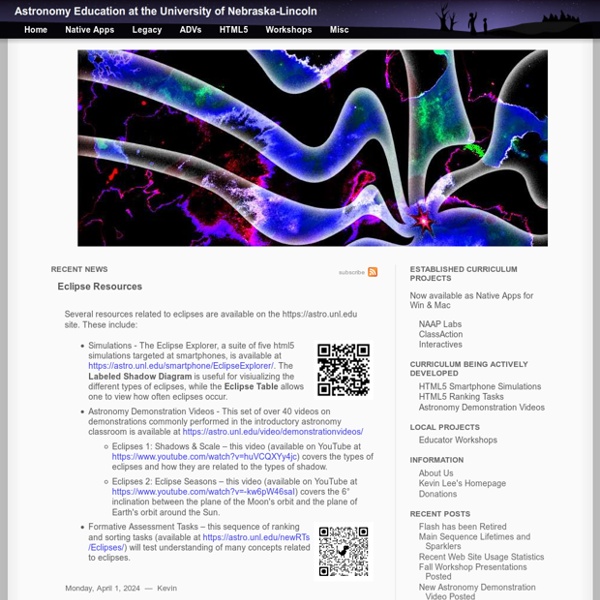



Physics Flash Animations We have been increasingly using Flash animations for illustrating Physics content. This page provides access to those animations which may be of general interest. The animations will appear in a separate window. The animations are sorted by category, and the file size of each animation is included in the listing. Also included is the minimum version of the Flash player that is required; the player is available free from The categories are: Determine Your Longitude With Jupiter's Moons It was MIT physicist Philip Morrison on a television documentary who taught me how to use Jupiter's moons as a system for synchronizing clocks, the first step in calculating longitude with astronomical observations. With an ephemeris for Jupiter satellite transits and occultations that is accurate for the time at the Royal Greenwich Observatory, you can synchronize your clock to the observatory's by watching the scheduled event. The difference between your local time and Greenwich local time reveals your longitude.
59-240 Physical Chemistry Animations Electromagnetic Wave - Java Chapter 1: Gases Phases of Matter at the Molecular Level (L1) - Java Phases of Matter and Containers (L1) - Shockwave Phases of Water - Java Motion of Particles in Solids - Shockwave ISU Ideal Gas Law (L2) - Java Plotting the Ideal Gas Law (L2) - Java MSU Elastic Collisions of Hard Spheres (L1) - Java Brownian Motion (L1) - Java Ideal Atmosphere - (L3) Java - Phys. Chem. & Atmospheric Sciences UCI Molecular Weights, Pressure and Average Molecular Speeds - Java Maxwell Distribution (L3) - Java Maxwell Distribution (L3) - UC Davis Kinetic Molecular Theory (L2, L3) - UC Davis
SIMBAD Astronomical Database What is SIMBAD, and what is it not ? % The purpose of Simbad is to provide information on astronomical objects of interest which have been studied in scientific articles. Math, Physics, and Engineering Applets Oscillations and Waves Acoustics Signal Processing Electricity and Magnetism: Statics Lunar Sinuous Rilles Atlas The Atlas of Lunar Sinuous Rilles is a comprehensive collection of images of 195 lunar sinuous rilles that are globally distributed around the Moon. The interface for the atlas, seen below, contains red circles that represent the source locations of each sinuous rille. Sinuous rilles are identified with numbers that correlate with a matching set of numbers in a database accessible at a link below. The atlas allows the user to zoom into the sinuous rille of interest by centering the region of interest on the screen and scrolling the mouse wheel or clicking shift on the keyboard (click control to zoom out).
Physics Flash Animations We have been increasingly using Flash animations for illustrating Physics content. This page provides access to those animations which may be of general interest. The animations will appear in a separate window. The animations are sorted by category, and the file size of each animation is included in the listing. Kepler's laws of planetary motion In astronomy, Kepler's laws of planetary motion are three scientific laws describing the motion of planets around the Sun. Kepler's laws are now traditionally enumerated in this way: Figure 1: Illustration of Kepler's three laws with two planetary orbits. (1) The orbits are ellipses, with focal points ƒ1 and ƒ2 for the first planet and ƒ1 and ƒ3 for the second planet. The Sun is placed in focal point ƒ1. (2) The two shaded sectors A1 and A2 have the same surface area and the time for planet 1 to cover segment A1 is equal to the time to cover segment A2.
Saturn's strange north pole is a giant hexagon We've learned a lot about Earth's atmosphere and climate by studying other planets. As the American Institute of Physics writes: "In the 1960s and 1970s, observations of Mars and Venus showed that planets that seemed much like the Earth could have frightfully different atmospheres. The greenhouse effect had made Venus a furnace, while lack of atmosphere had locked Mars in a deep freeze. This was visible evidence that climate can be delicately balanced, so that a planet's atmosphere could flip from a livable state to a deadly one." The photo above was taken over Saturn's north pole by NASA's Cassini orbiter on November 27, 2012 from a distance of 376,171 kilometers (233,742 miles).
SHTOOLS - Tools for working with spherical harmonics The current version of SHTOOLS is 2.1 (released October 20, 2006) What is SHTOOLS? SHTOOLS is an archive of fortran 95 based software that can be used to perform (among others) spherical harmonic transforms and reconstructions, rotations of spherical harmonic coefficients, and multitaper spectral analyses on the sphere. John Baez's Stuff This Week's Finds - Latest Edition Fun Stuff Serious Stuff Talks Seminar Diary Twitter Google+ Azimuth Blog Azimuth Project Visual Insight n-Category Café Physics FAQ I'm a mathematical physicist. I work at the math department at U. C.
Cet site est très utiles pour l'enseignement de l'astronomie car il contient un logiciel avec plus de 250 questions en lien avec l'astronomie local ou extra-système solaire. De plus, il y a des animations qui peuvent nous aider à comprendre des phénomènes terrestres ou lunaires. by emileboucher Apr 17